7th March 1942 (Sat)
Ships Log "Orders received to evacuate Rangoon and blow it up. Demolition charges replaced, and arrangements made to blow.
09.30 Sailed down Rangoon River to "Dry Tree Point" where convoy anchored to evacuate troops.
Brewer left behind to carry out part of demolition.
14.00 Demolition of Rangoon and amazing site - Terrific fires at oil refineries and wharfs. 80.000 tons oil fuel at one shot.
Embarking troops all afternoon and evening, and sinking all small craft in river. Dry Tree Point blown up." [5]
The volunteer civilians assisting the scorched earth policy, known as the last dichers were ordered to evacuate.
L/S Les Barker "Loading lead." [24]
8th March 1942 (Sun)
The Commodore, Rear Admiral Cosmo M Graham, along with Gandy, Collingwood, Ashby and the remaining ratings departed Rangoon on board the Commodore's Flag Ship, the Danish registered "Heinrich Jessen" under the command of 31 year old Danish Captain George Rhod Hansen. This was the last Merchant ship to leave the port of Rangoon. [51]
Force Viper proceeded up the Irrawaddy, reaching Prome on 13th.
Ships Log "05.00 All demolition parties on board. Got under way for Calcutta. Ready all day for air attacks, but for some reason they did not came " [5]
Lt Kennedy RNVR "The military withdrawal from Rangoon was almost over.
The Commodore left Rangoon in the 'Jessen' after the docks had been demolished, and was accompanied by Gandy and the rest of the MTB party.
The 'Somagyi' was patrolling off the Irrawaddy with two ML's." [9]
Lt-Cmd Gandy submitted his report to the Commodore for the attention of the Amiralty, Far East Command, on the battle for Hong Kong and subsequent escape. [15]
A/B Stoker Lenny Rann "Rangoon was finally evacuated and when I last saw the city, large fires were burning as the scorched earth policy had been thoroughly carried out. My vessel left in a small convoy for Akyab." [63]
Lt Collingwood RN "We actually left Rangoon three times, returning twice, the third time we went to Calcutta." [8]
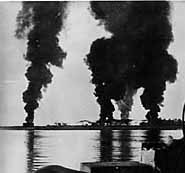 PO Buddy Hide "We left and returned to Rangoon three times, the last time to blow up everything, the godowns (warehouses), jetties, piers, wireless station and all military places. Then we proceeded downstream, and then we stopped to blow up and set fire to the oil refineries, dumps, and works. We could see the fires burning forty mile out at sea." [21]
PO Buddy Hide "We left and returned to Rangoon three times, the last time to blow up everything, the godowns (warehouses), jetties, piers, wireless station and all military places. Then we proceeded downstream, and then we stopped to blow up and set fire to the oil refineries, dumps, and works. We could see the fires burning forty mile out at sea." [21]
Maj-Gen S W Kirby "As the launches passed down Rangoon River against a strong flood-tide a strange spectacle was presented to the eyes of the weary passengers. A heavy pall of smoke hung over the town but a light southerly wind kept the smoke off the foreshore and it could be distinguished that the electric power station was ablaze, there were fires at Sule Pagoda wharf where the port warehouses were blackened skeletons of what they had once been; on the docks the cranes, damaged by dynamite, leant over at a drunken angle and the columns of smoke rising behind the wharves indicated the end of the principle buildings of a city of half a million inhabitants. All along the normally thronged foreshore not a sign of human life was to be seen. By the time that Syriam was abeam it was almost dark when the flames, topped by columns of dense black smoke rising thousands of feet into the air from the oil refineries presented an awe-inspiring sight, and as the night fell the whole sky was lurid with the glare of that inferno." [96]
Lt Ashby HKRNVR "After making the final demolitions and setting fire to oil installations, we escaped in a speedboat to a ship." [5]
PO Prest "The Japanese were knocking hell out of Rangoon, preparatory to their final assault. We escaped in the teeth of the final assault -- on the last British merchant ship to leave the port." [84]
L/S Les Barker "4pm. Left for Calcutta. Rangoon well ablaze and abandoned. Fires blazing hundreds of feet in to the air. One long blaze." [24]
The "Jessen" was later commandeered by the Royal Indian Navy and re-named HMIS Barracuda serving as a depot ship during the Arakan campaign, and representing the coastal forces was in the the first wave of ships, representing the Coastal Forces, to sail back into Rangoon to witness the Japanese surrender on 12th September 1945.
Lt Pittendrigh RNRwas seconded into the British Indian Army with the rank of 1st Lieutenant. Arthur demobilised in 1945 with the rank of Major. He returned to Hong Kong to command the Maritime Police Service with the rank of Colonel.
9th Mar 1942 (Mon)
Ships Log "At sea in convoy bound for Calcutta. ML's and tugs sent to Akyab with certain MTB officers and ratings. (Kennedy) " [5]
The Japanese entered an eerily quiet and deserted Rangoon.
10th Mar 1942 (Tues)
Ships Log "At sea, nothing to report. Arrived off Sands Heads, anchored waiting ???? " [5]
11th Mar 1942 (Wed)
Ships Log "06.00 proceeded up Hoogli river to Calcutta and secured alongside Garden Reach jetty 03.00." [5]
12th Mar 1942 (Thurs)
PO Buddy Hide "We arrived in Calcutta after five days at sea. Two hours after we left, a Japanese armored column arrived in Rangoon." [21]
L/S Les Barker "Arrived in Calcutta. News that the Japanese had entered Rangoon two hours after we had left. At Calcutta. Moved in to the Marine Club." [24]
Ships Log "At Calcutta. Very pleasant, is our first bit of civilization since Dec 8th. Calcutta apparently quite unaware that war existed anywhere." [5]
13th Mar 1942 (Fri)
L/S Stoker Lenny Rann "On arrival (at Akyab) I met several of my comrades on the long journey from Hong Kong to Burma. We did patrol duties again until March 23rd." [63]
Lt Kennedy RNVR "Indian refugees camped in their hundreds along the foreshore (Akyab), and any sanitary arrangements which might have been made for them were completely overwhelmed." [9]
15th Mar 1942 (Sun) David MacDougall arrived in London from Lagos, the first of the Christmas Day escape party to complete a home run. [26]
17th Mar 1942 (Tues)
Ships Log "Lt Ashby flew to Akyab with Commodore Grayham on special mission. Remainder of party ashore at Marine Club." [5]
Lt Collingwood stayed on the "Heinrich Jessen" which set sail immediately for Akyab (Sittwe) on the Arakan coast of Burma in the Bay of Bengal where he then took command of an R. I. N. sloop assisting refugee relief.
Lt Collingwood possibly had SPO Moore, PO Burrows, and Stoker A/B Jack Thorpe on board an RIN Sloop on refugee relief as Collingwood was fluent in Hindi. [8]
Lt Collingwood RN "From there we
went directly to a port with an airstrip, at Akyab, being used by RAF planes to re-fuel. The Royal Indian Navy had a sloop there and several craft." [8]
Lt Kennedy RNVR "By the time the Somagyi's wireless had been patched up the Telegraphist had deserted and could only be replaced by having a rating specially released from the local jail." [9]
19th Mar 1942 (Thurs)
David MacDougall is the first escapee to arrive back in the UK having flown via Lagos in Nigeria after leaving Chungking on the 20th February. [26]
20th Mar 1942 (Fri)
Lt Kennedy RNVR "We patrolled south of Ramree Island for several days without sighting a ship of any kind, and landed parties at various points on the coast to reconnoitre." [9]
19th Mar 1942 (Thurs)
21st Mar 1942 (Sat)
Ships Log "Lt Ashby back in Calcutta from Akyab. Trip reasonable success." [5]
Lt Ashby HKRNVR returned to Burma as Senior Naval Officer, Coastal Forces for the the Arakan campaign for the re-taking of Burma and as such, was one of the few RNVR officers to reach the rank of acting Captain. He had 8 flotillas of Fairmile “B” M. L’s (65 boats) with all their attendant landing craft and support ships. The M. L's depot and maintenance ship was the old "Heinrich Jesson," the ship on which he had escaped from Rangoon in 1942 and now named "HMIS Barracuda." [5]
22nd Mar 1942 (Sun)
Ships Log "Orders for Lt-Cmd Gandy - Lt Ashby and party of Hong Kong ratings to proceed to Bombay by train en-route to UK." [5]
A/B Bob Hempenstall was hospitalised with fever, while Coxswain Bill Schillemore and A/B Les Gurd joined the staff of the Department of Medical services (DMS) in Calcutta. [15]
23rd Mar 1942 (Mon)
Lt Kennedy RNVR "When we returned to Akyab there was considerable activity in the port, and the 'Clan Murdoch' lay alongside the quey discharging a load of bombs for the RAF.
The Headquarter ship 'Jessen' was at anchor further up harbour (Akyab) and we found that she had already been to Calcutta, where Gandy and the MTB ratings had left her bound for home. Our immediate reaction was of envy, but this changed to excitement when a signal came through for the rest of the party containing the magic words 'Proceed to UK'
Later the same day when I was ordered at short notice to embark in the 'Ellenga' with my ratings for Calcutta, it looked as though we were just a step ahead of the Japanese once more.
The 'Ellenga' had her deck space packed with refugees. There were over two thousand of them in all." [9]
A/B Stoker Lenny Rann "The Jap's bombed the port, and we eventually left Akyab in a coastal passenger ship for Calcutta, where we arrived two days later." [63]
24th Mar 1942 (Tues)
Ships Log "Left Calcutta (Howrah Street) for Bombay." [5]
Gandy's party boarded the train for the thirty six hour journey across the Indian sub-Continent to Bombay. Leaving Calcutta station was an experience never to be forgotten, with people crossing the line with just inches to spare. Others hanging on externally as the engine began to pick up speed. The scenery was everlastingly interesting and at times the train overtook wandering elephants walking alongside the railway.
As Gandy, Ashby, and` ratings departed Calcutta for Bombay, Kennedy along with his fifteen ratings left Akyab (Sittwe) on board the five thousand ton British India Steam Navigation Company's " SS Ellenga" bound for Calcutta with over two thousand refugees crammed on deck. [9]
Lt Collingwood RN "One RIN sloop captain did a bunk and so the Commodore put me in command, I being the only officer who could speak Hindi (of course he could speak Hindi because he had been a P&O officer and they carried Indian crews). There were hundreds of Indian refugees here but there was a good supply of rice, but at nearby Mondaw there was a serious shortage so I was sent there bearing supplies for the Indian refugees. My vessel was given meat by the locals in exchange for bringing the rice. From here I went to Chittagong and from there to Calcutta by air and then home." [8]
26th Mar 1942 (Thurs)
Gandy and party arrived at "Victoria Terminus", now CST the most magnificent building in Bombay, at 10.00.
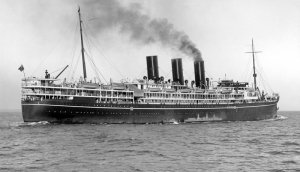 Ships Log "10.00 arrived Bombay to find car and truck waiting to take party straight on board SS Narkunda sailing that afternoon. Still no time to have clothes made. 15.30 sailed for Durban en-route UK." [5]
Ships Log "10.00 arrived Bombay to find car and truck waiting to take party straight on board SS Narkunda sailing that afternoon. Still no time to have clothes made. 15.30 sailed for Durban en-route UK." [5]
L/S Les Barker "Arrived at Bombay. Embarked and sailed on SS Narkunda for UK. Thank goodness." [24]
Lt Kennedy RNVR "We entered the Hoogli and berthed at Calcutta before noon. We were determined to waste no more time now that we were really on the way home, and by evening had boarded the train for Bombay." [9]
Gandy, Ashby, and the party of ratings boarded the sixteen thousand five hundred ton former Peninsular & Oriental (P&O) 1st class luxury liner "Narkunda," now armed, under the command of Captain M G Draper. The SS Narkunda slipped and proceeded at 1530 bound for Durban along with survivors from the two Capital ships "HMS Prince of Wales" and "HMS Repulse," that had been sunk by the IJA on the 10th December 1941.
27th March - 5th April 1942
Ships Log "At sea" (The final entry in the Fair Log of MTB 07) [5]
28th Mar 1942 (Sat)
Lt Kennedy RNVR "There was just sufficient time before being bundled on board the twenty-thousand ton Cunarder 'Laconia' to change our Burmese money and do some very necessary shopping.
I collected my orders as 'Officer Commanding Naval Draft', a somewhat pompous title for there were only fifteen ratings on board.
The SS 'Laconia’ mounted two six-inch guns which had been left for her protection when she ceased to fly the white ensign and the naval draft was formed into spare gun-crews." [9]
A/B Stoker Lenny Rann "We left Bombay on our journey home on March 28th and the ship put in at Cape Town en route." [63]
6th Apr 1942 (Mon)
The Narkunda arrived in Durban to take on board 657 Italian POW's. Lt-Commander in charge of Naval draft guarding 657 Italian POW's on board the Narkunda on passage to UK.
9th Apr 1942 (Thurs)
HMT Narkunda departs Durban en route to UK via Cape Town.
12th Apr 1942 (Sun)
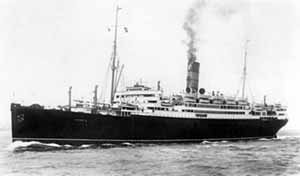 Lt Kennedy RNVR "The "Laconia" was followed into harbour (Cape Town) by another troopship, the "Narkunda", and to our surprise Gandy and the other half of the MTB party were on board. We had not expected to be ahead of them, but they had called at Durban to embark Italian POW's.
Lt Kennedy RNVR "The "Laconia" was followed into harbour (Cape Town) by another troopship, the "Narkunda", and to our surprise Gandy and the other half of the MTB party were on board. We had not expected to be ahead of them, but they had called at Durban to embark Italian POW's.
We were ordered to transfer and so all joined forces again after an interval of two months. The "Laconia" party received a warm welcome, perhaps not so much as old ship-mates but as extra hands to share duties of guarding the six hundred Italian prisoners-of war being taken to England in the ship.
On board the Narkunda the MTB party was almost complete again, but I found that Tommy Brewer, my First Lieutenant, had not left Rangoon with the others. He was last seen doing demolition work ashore and had presumably tried to get away in his jeep. It was one of the strange ironies of war that although he got through the Japanese cordon with his usual aggressiveness and arrived safely in England, he was killed in a road accident soon afterwards." [9]
Sub-Lt Tommy Brewer stayed on in Burma serving on ML1104 gaining an MiD in June "For Bravery and Resolution while serving in Burma." along with five fellow Burmese RNVR officers in 1942.
The officers were able to purchase new uniforms in Cape Town from the military tailors A H Bruce & Co (PTY) Ltd at GB£12.00 each.[5]
19th Apr 1942 (Sun)
Lt Kennedy RNVR "The 'Narkunda' left Cape Town a week later, but was forced to return owing to engine trouble. No one minded very much until she anchored out in the bay and it was discovered that there no boats running to the shore for leave." [9]
28th Apr 1942 (Tues)
Lt Kennedy RNVR "Sailed from Cape Town on the twenty-eighth of April after having her engines patched up." [9]
It was an uneventful ten-day passage to Freetown Harbour in Sierra Leone, where the Royal Navy had a shore base (Pay Station)
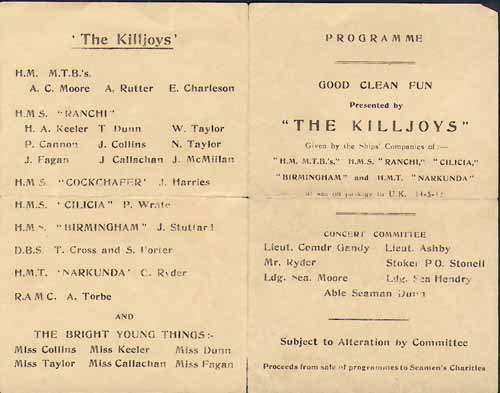
8th May 1942 (Fri)
HMT 'Narkunda' arrived in Freetown Harbour in Sierra Leone.
After two days re-victualing the Narkunda shaped course for the UK.
15th May 1942 (Thur)
A concert called
"The Killjoys" arranged and organized by Lt-Cdr Gandy, Lt Ashby,
PO Stonell, & L/S (Pony) Moore and was performed by the ships companies onboard of HMTB's, HMT
"Narkunda", HMS "Ranchi", "Cilicia," "Cockchafer," &
"Birmingham" The performers from the MTB's were (Pony) Moore, Al Rutter, & Eddie Charleson.
Photos from the Hide collection ©
As they headed north, frequent life boat exercises were carried out and the order to sleep fully dressed was given as they negotiated the U-boat packs in the north Atlantic, continuously zigzagging en route for the UK.
22nd May 1942 (Fri)
Oliver Lindsay Author "Almost five months to the day after evading the Japanese in Hong Kong, the remnants of the 2nd MTB Flotilla reached Glasgow, thereby completing a remarkable journey through the corridors of war. Tragically Sub-Lieutenant Brewer, who reached England via a different route, had come too far; he was killed in a motor cycle accident on the A1 road at the start of his leave." [80]
My research only shows Gandy, Ashby, & Kennedy along with twenty two of the original thirty four ratings of the 2nd MTB flotilla that escaped from Hong Kong arrived at the King George V dock, Sheildhall, Glasgow late afternoon on board the HMT "Narkunda." [15]
1st June1942 (Mon)
A/B Len Downey, the old China hand and longest serving rating with the flotilla arrived back in Blighty, possibly with the remaining six Telegraphist's who had been put under Lt-C dr Dinky on 21st February and other ratings. [2]
PO Buddy Hide immediately made arrangements to marry his long term girlfriend, they married the following week. After a short leave he was posted back out to the Far East.
Lt Kennedy RNVR officially announced his engagement to his girlfriend Rachel Smith who arrived on the same tide in Glasgow after leaving Hong Kong at the outbreak of hostilities and sailing in the opposite direction round the world. [9]
Two ratings remained in Calcutta with the Department of Medical services (DMS).
One rating remained in hospital in Calcutta.
Lieutenant Commander Gandy R. N. (Ret) had prevailed against all the odds, and triumphed over adversity to deliver his people back to freedom without loss of life or serious injury after evading capture and escaping from Hong Kong on Christmas Day 1941.
PO Buddy Hide "On the whole, the moral, spirits, and courage of the party was magnificent. I think it was the shear thoughts of beating the Jap's, and the prospects of getting home after three years, some of us four years from home, that made us carry on." [21]
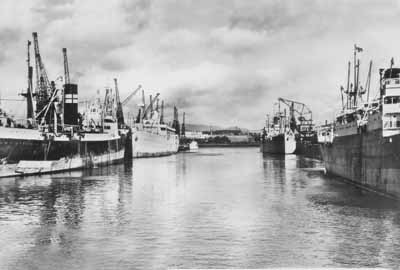
King George V Dock; Aerial photo from the Glasgow City Archives, Photographic Series ©
It is unique in British Coastal Forces that the personnel of a flotilla, with some base staff, having been overcome by invasion and conquest of their isolated operating port, should set out as a group to find their way to freedom across an entire continent through enemy territory in order to be able to fight again.[17a]
David MacDougall was the first of the escape party to arrive in the UK in mid March, having been flown back for surgery to remove the bullet he was carrying in his back. [92]
This epic escape proved to be the pathfinder for several thousand further Sino/British POW and civilian escapees from Hong Kong. The escapees were sworn to secrecy regarding the route and the fact that special forces were involved, and as such remained as classified information for thirty years, and was only officially released from the British National Archives in 1972.
Commander Ron Ashby DSC VRD RNVR as Commanding Officer of Coastal Forces in the 2nd Arakan campaign under Admiral Lord Mountbatten played a most significant part in the re-taking of Rangoon, Singapore and Hong Kong from the oppression of the Japanese. To this end the Arakan Campaign, led by Admiral Lord Mountbatten and General Sir William Slim, was of vital importance.

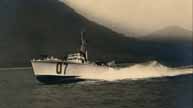
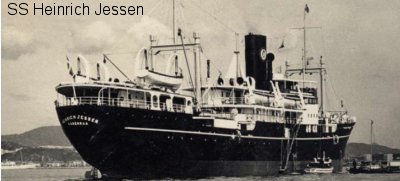
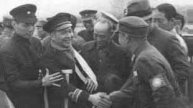
 PO Buddy Hide
PO Buddy Hide
 Lt Kennedy RNVR
Lt Kennedy RNVR


